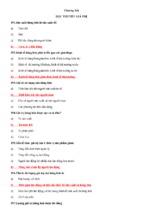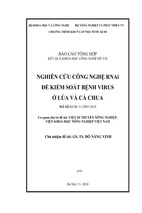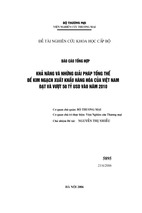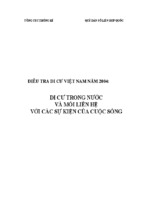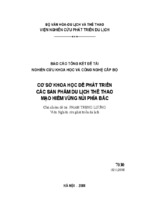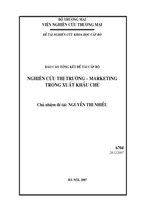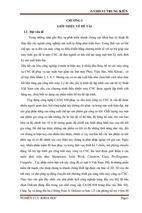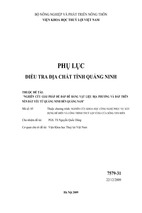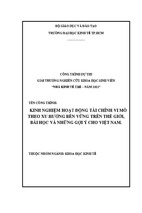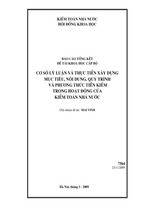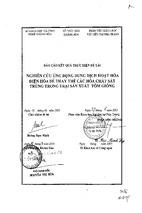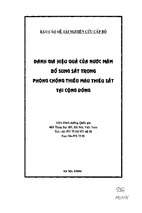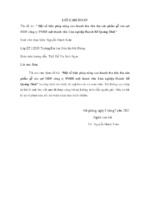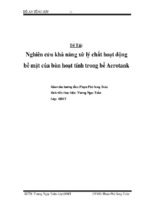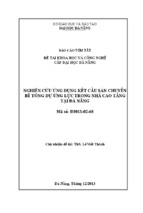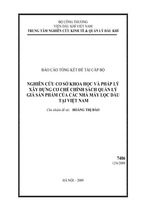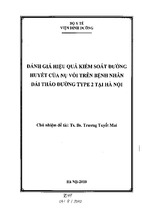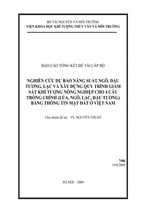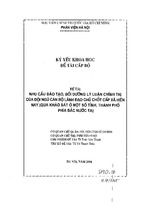CHAPTER 1
INTRODUCTION
1.1.
Problem statement:
Today, when Vietnam is going to market economy, three different types of
business that operated for profit: manufacturing, merchandising, and service business
are more growing up rapidly. Each type of business has unique characteristics.
Manufacturing businesses change basic input into products that are sold to
individual customers, such as Thai Tuan Textile and Garment Corporation, Dong Tam
Joint Stock Corporation…Merchandising businesses also sell products to customers.
However, rather than making the products, they purchase them from other businesses
(such as manufacturers). In this sense, merchandisers bring products and customers
together, such as 3A Pharmaceutical Co., Ltd - Abbott Authorized Distributor, Thuy
Loc Co., Ltd - Shiseido Authorized Distributor in Viet Nam or Metro Cash & Carry…
Service businesses provide services rather than products to customers, such Equinox
Hair & Beauty, YKC Beauty Spa…
One of the key factors underlying the growth of the Vietnam economy is
the trend toward selling goods and services on credit. Because, in today’s global
marketplace, competitive pressure and industry practice mandate that products and
services be on a credit vs. cash-on-delivery basis. This practice often produces a
receivable asset is one of the largest tangible assets on a company’s balance sheet. A
review of the 2004 Fortune 500 certainly reveals this truth. Receivables ranked among
the top three tangible assets for 75% of the top 100 companies. Surprisingly,
management of this multi-million (or multi-billion) Vietnam Dong asset rarely
receives much senior management attention, except when a serious problem develops.
The custodians of the receivables asset are similar to umpires of a football game; they
are not noticed unless they do a bad job.
As you see above, merchandising is the type that is less complicated than
manufacturing, but more complex than service. So we choose merchandising business
Page 1 of 53
to discuss the importance of receivable management. This is the AAA Pharma Co.,
Ltd – John & John Authorized Distributor in Viet Nam.
1.2.
Significance and contribution of the thesis:
It can be argued that revenue generation is the most critical function of a
company. Any business tries to expense their substantial resources to generate
increasing levels of revenue. But this revenue must be converted into cash since cash
is lifeblood of a company. In the result, every Vietnam Dong of a company’s revenue
becomes a receivable that must be managed and collected.
1.2.1.
Benefits to the society:
The good receivable management can be able to:
Decrease the risk of bankruptcy from receivable failure.
Increase the trading environment well among business because of
higher credit.
1.2.2.
Benefits to the business:
Effectively managing the receivables asset is:
1.2.3.
To Increase cash flow.
To get higher credit sales and margins.
To reduce bad debt loss.
To get lower administrative cost in the entire revenue cycle.
To decrease deductions and concession losses.
To decrease administrative burden on sales force.
To enhance customer service.
Benefits to myself:
Doing my thesis for two months, I get deeply inside receivable
management. It let me know how it affects on cash flow, runs effectively, and also
gives more ways to improve cash inflow. It means that the way I can increase
revenue, enhance customer satisfaction and reduce expense.
Page 2 of 53
1.3.
Objectives of the thesis:
After studying in real case, you may know how receivable management is
important by
Identifying accounts receivable in merchandising business.
Describing how accounts receivable are recognized, valued and
disposed in the accounts.
Interpreting the statement presentation and analysis of receivable.
Illustrating receivable asset management effectively.
Optimizing receivables.
Providing proven principles for achieving benefits such as increased
cash flow, higher margins, and a reduction in bad debt loss.
Supporting technology.
1.4.
Scope of the thesis:
1.4.1.
By time:
AAA Pharma has expended their business more than ten years with many
changes in receivable management. Because of limit time, I just focus within two
years to analyze and improve it for current and coming year.
1.4.2.
By space:
AAA Pharma has not only a head quarter at Ho Chi Minh City but also
many branches in all three areas in Vietnam: Ha Noi, Da Nang, Can Tho, Nha Trang,
Hai Phong, Dong Nai, Nghe An and a representative office in Hue. Because of limit
space, my major is receivable management at head quarter in Ho Chi Minh City.
1.4.3.
By topic:
The focus is primarily on commercial receivables management (business
to business, and business to consumer) and fast-growing consumer product.
Page 3 of 53
CHAPTER 2
LITERATURE REVIEW
2.1.
Identify account receivables in merchandising business:
2.1.1. Types of receivables:
The term “receivables” refers to amounts due from individuals and other
companies. They are claims that are expected to be collected in cash. Receivables are
frequently classified as (1) accounts, (2) notes, and (3) other.
Accounts receivable are amounts owned by customers on account. They
result from the sale of goods. These receivable generally are expected to be collected
within 30 to 60 days. They are the most significant type of claim held by a company.
Notes receivable are claims for which formal instruments of credit are
issued as proof the debt. A note receivable normally extends for time periods of 60-90
days or longer and requires the debtors to pay interest.
Notes and accounts receivable that result from sale transactions are often
called trade receivable.
Other receivables include nontrade receivables. Examples are interest
receivable, loans to company officers, advances to employees, and income taxes
fundable. These are unusual. Therefore they generally classified and reported as
separate items in the balance sheet.
2.1.2. Reasons to offer credit: (chấp nhận cho nợ)
Most of companies want to sell for cash at that time they provide goods
because cash sales are normally rung up on a cash register (cashbox) and recorded in
the accounts. But competitive pressure in the world economy mandates that goods are
sold on credit as promotion, customer convenience. You may thinks this credit they
offer is to bring more benefits only for customers. That is not enough. The more
customers you have, the more profit you earn and the higher market share you get in
Page 4 of 53
competitive pressure. Credit had existed in business environment for long time ago;
therefore it is available to customers and become a criterion they make buy decision.
2.2.
Three primary accounting issues are associated with
accounts receivable:
2.2.1.
Recognizing accounts receivable:
Every sales transaction should be supported by a business document that
provides written evidence of the sales. A sales invoice provides support for a credit
sale. Two entries are made for each sale.
The first entry records the sale:
Accounts receivable is increased by a debit.
Sale is increased by a credit.
The second entry records the cost of goods sold:
Cost of goods sold is increased by a debit.
Merchandise inventory is decreased by a credit.
2.2.2.
Valuing accounts receivable: (đánh giá khoản phải
thu)
Once receivables are recorded in the accounts, the next question is: how
should receivables be reported in the financial statements? They are relatively liquid
assets, usually converting into cash within a period of 30 to 60 days. Therefore
accounts receivable from customers usually appear in the balance sheet as current
asset. But determining the amount to report is sometimes difficult because some
receivables will become uncollectible.
Reflecting Uncollectible Accounts in the Finance Statements
Each customer must satisfy the credit requirements of the seller before the
credit sale is approved. Inevitably, though, some accounts receivable become
uncollectible. For example, one of your customers may not be able to pay because of
a decline in sales due to a downtown in the economy. Similarly, individuals may be
laid off from their jobs or be faced with unexpected hospital bills. Credit losses are
recorded as debit to Bad Debts Expense (or Uncollectible Accounts Expense). Such
losses are considered a normal and necessary risk of doing business on a credit basis.
Page 5 of 53
Two methods are used in accounting for uncollectible accounts:
2.2.2.1.
Direct write-off Method for Uncollectible Accounts:
(phương pháp xóa sổ nợ khó đòi)
When a particular account us determined to be uncollectible, the loss is
charge to Bad Debts Expense. The entry is:
Bad Debts Expense is increased by a debit.
Accounts receivable is decrease by a credit.
Under the direct write-off method, Bad Debts Expense will show only
actual losses from uncollectible. Accounts receivable will be reported at its gross
amount. Although this method is simple, its use can reduce the usefulness of both the
income statement and balance sheet. Moreover, Bad Debts Expense is often recorded
in a period different from the period in which the revenue was recorded. No attempt is
made to match bad debt expense to sale revenues in the income statement. Nor does
the direct write-off method show accounts receivable in the balance sheet at the
amount actually expected to be receivable. Consequently, unless bad debts losses are
insignificant, the direct write-off method is not acceptable for financial reporting
purposes.
2.2.2.2.
Allowance method for Uncollectible Accounts:
(Phương pháp dự phòng nợ khó đòi)
The allowance method of accounting for bad debts involves estimating
uncollectible accounts at the end of each period. This provides better matching on the
income statement and ensures that receivables are stated at their cash (net) realizable
value on the balance sheet. Cash (net) realizable value is the net amount expected to
be receivable in cash. It excludes amounts that the company estimates it will not
collect. Receivables are therefore reduced by estimated uncollectible receivable in the
balance sheet through use of this method.
The allowance method is required for financial reporting purposes when
bad debts are material in amount. It has three essential features:
Page 6 of 53
Uncollectible accounts receivables are estimated. This estimate is
treated as an expense and is matched against sales in the same accounting period in
which the sales occurred.
Estimated uncollectibles are debit Bad Debts expense and are
credited to Allowance for Doubtful Account (a contra asset account) through an
adjusting entry at the end of each period.
When a specific account is written off, actual uncollectible are
debited to Allowance for Doubtful Accounts and credited to Accounts Receivable.
2.2.2.2.1.
Recording estimated uncollectible:
To illustrate the allowance method, assume that AAA Pharma has credit
sales of 120 million VND in 2002. Of this amount, 20 millions VND remains
uncollected at Dec 31. The credit manager estimates that 12 million VND of these
sales will be uncollected. The adjusting entry to record the estimates uncollectible is:
Bad debts expense is increased by 12 millions debits.
Allowance for Doubtful Accounts is increased by 12 millions
credits.
Bad debts expense is reported in the income statement as an operating
expense. Thus, the estimated uncollectible are matched with sales in 2002. The
expense is recorded in the same year the sales are made.
Allowance for Doubtful Accounts shows the estimated amount of claims
on customers that are expected to become uncollectible in the future. This contra
account is used instead of direct credit to Account Receivable because we do not
know which customers will not pay. The credit balance in the allowance account will
absorb the specific write-off when they occur. It is deducted from accounts receivable
in the current assets section of the balance sheet. Allowance for Doubtful is closed at
the end of the fiscal year.
2.2.2.2.2.
Recording the write-off an uncollectible account:
Companies use various methods of collecting past-due accounts, such as
letters, calls, and legal action. When all means of colleting a past-due account have
been exhausted and collection appears impossible, the account should be written off.
Page 7 of 53
To illustrate a receivable write-off, assume that CFO of AAA Pharma
authorizes a write-off of the 5 millions VND balance owed by Tien Viet Company on
March 1, 2003. The entry to record the write-off of is
Allowance for Doubtful Account is decreased by 5 million debits.
Account receivable is decrease by 5 million credits.
Bad debts expense is not increased when the write-off occurs. Under
allowance method, every bad debt write-off is debited to the allowance account rather
than to Bad debts expense. A debit to Bad debts expense would be incorrect because
the expense has already been recognized when the adjusting entry was made for
estimated bad debts. Instead, the entry to record the write-off of an uncollectible
account reduces both Account Receivable and the Allowance for Doubtful Accounts.
A write-off affects only balance sheet accounts. The write-off the account
reduces both Accounts Receivable and Allowance for Doubtful Accounts. Cash
realizable value in the balance sheet, therefore, remains the same.
2.2.2.2.3.
Recovery of an uncollectible account:
Occasionally, a company collects from a customer after the account has
been written off. Two entries are required to record the recovery of a bad debt: (1) the
entry made in writing off the account is reversed to reinstate the customer’s account.
(2) The collection is journalized in the usual manner.
Recovery of a bad debt, like the write-off of a bad debt, affects only
balance sheet accounts. The net effect of the two entries is debit to Cash and a credit
to Allowance for Doubtful. Receivable is debited and the Allowance for Doubtful is
credited in entry (1) for two reasons: First, the company made an error in judgment
when it wrote off the account receivable. Second, after customers did pay, Account
receivable in the general ledger and customer’s accounting the subsidiary ledger
should show the collection for possible future credit purposes.
2.2.2.2.4.
Bases used for allowance method:
Company must estimate the amount of the expected uncollectible if they
use the allowance method. Two bases are used to determine this amount: (1)
percentage of sales, and (2) percentage of receivables. Both bases are generally
Page 8 of 53
accepted. The choice is a management decision. It depends on the relative emphasis
that management wishes to give to expenses and revenues on the one hand or to cash
realizable value of the accounts receivable on the other. The choice is whether to
emphasize income statement or balance sheet relationships.
Figure 1: Percentage of sales
In the percentage of sales basis, manager estimates what percentage of
credit sales will be uncollectible. This percentage is based on past experience and
anticipated credit policy. The percentage is applied to either total credit sales or net
credit sales of the current year.
For example, AAA Pharma estimated 1 percentage of net credit sales will
become uncollectible. If net credit sales for 2002 are 800 million, the estimated bad
debts expense is 8 million (1% * 800 million).
This basis of estimating uncollectible emphasizes the matching of
expenses with revenues. As a result, Bad Debts Expense will show a direct percentage
relationship to the sales base on which it is computed. When the adjusting entry is
made, the existing balance in Allowance for Doubtful Account is disregarded. The
adjusted balance in this account should be a reasonable approximation of the
uncollectible receivable. If actual write-off differs significantly from the amount
estimated, the percentage for future years should be modified.
Page 9 of 53
Figure 2: Percentage of receivables
Under the percentage of receivable basis, manager estimates what
percentage of receivable will result in losses from uncollectible accounts. An aging
schedule is prepared, in which customer balances are classified by the length of time
they have been unpaid. Because of its emphasis on time, the analysis is often called
aging the account receivable.
After the accounts are aged, the expected bad debt losses are determined.
This is done by applying percentages based on past experience to the totals in each
category. The longer a receivable is past due, the less likely it is to be collected. So,
the estimated percentage of uncollectible debts increases as the number of days past
due increase. An aging schedule for AAA Pharma is shown:
Page 10 of 53
Table 1: Aging schedule
Total estimated bad debts for AAA Pharma (2,228 millions) represent the
amount of existing customer claims expected to become uncollectible in the future.
This amount represents the required balance in Allowance for Doubtful accounts at
the balance sheet date. The amount of the bad debt adjusting entry is the difference
between the required balance and the existing balance in the allowance account. If the
trial balance shows Allowances for Doubtful account with a credit balance of 528
million, an adjusting entry for 1,700 million (2,228-528) is necessary.
Occasionally the allowance account will have a debit balance prior to
adjustment. This occurs when write-off during the year have exceeded previous
provision for bad debts. In such a case the debit balance is added to the required
balance when the adjusting entry made. Thus, if there had been a 500 million debit
balance in the allowance account before adjustment, the adjusting entry would have
been for 2,728 million (2,228+500) to arrive at a credit balance 2,228 millions.
The percentage of receivable method will normally result in the better
approximation of cash realizable value. But it will not result in the better matching of
expenses with revenues if some customers’ accounts are more than one year past due.
In such a case, bad debts expense for the current period would include amounts
related to the sales of a prior year.
2.2.3.
Disposing of Account Receivable:
In the normal course of events, accounts receivable are collected in cash
and removes from the books. However, as credit sales and receivables have grown in
significance, their “normal course of events” has changed. Companies now frequently
sell their receivables to another company for cash, thereby shortening the cash-to-cash
operating cycle.
Receivables are sold for two reasons. First, receivable may be sold because
they may be the only reasonable source of cash. When money is tight, companies may
not be able to borrow money in the usual credit markets. Or, if money is available, the
cost of borrow may be prohibitive.
Page 11 of 53
A second reason for selling receivables is that billing and collection are
often time consuming and costly. It is often easier for a retailer to sell the receivable
to another party with expertise in billing and collection matters.
A common sale of receivable is sale to a factor. A factor is a finance company or bank
that buys receivable from businesses and then collects the payments directly from the
customers Factoring arrangements vary widely. Typically the factor charges a
commission to the company that is selling the receivables. This fee ranges from 1-3
percent of the amount of receivable purchased.
Figure 3: Sales of receivable to factor
2.3.
The statement presentation and analysis of receivable:
2.3.1. Receivables on the balance sheet:
All receivable that are expected to be realized in cash within a year are
presented in the Current Asset section of the balance sheet. It is normal to list the
assets in the order of their liquidity. This is the order in which they are expected to be
converted to cash during normal operations.
Page 12 of 53
Table 2: Balance sheet (partial)
2.3.2. Evaluating liquidity of receivable:
Business that grant long credit terms tend to have relatively greater
amounts tied up in accounts receivable than those granting short credit terms. In either
case, it is desirable to collect receivables as promptly as possible. The cash collected
from receivable improves solvency and lessens the risk of loss from uncollectible
accounts. Two financial measures that are especially useful in evaluating the
efficiency in collecting receivables are (1) the receivable turnover ratio, (2) the
number of days’ sales in receivable or average collection period.
The receivable turnover ratio measures how frequently during the year
the account receivable are being converted to cash. For example, with credit terms of
2/10, n/30 days, account receivable should turn over less than 36 times per year.
Receivable turnover ratio is computed as follow:
The average net receivable can be determined by using monthly date or by
simply adding the beginning and ending account receivable balances and dividing by
two.
Page 13 of 53
The number of days’ sales in receivable or average collection period is an
estimate of the length of time the account receivable have been outstanding. With
credit term of 2/10, n/30 days, the number of days’ sales in receivable should be more
than 10 days. The number days’ sale in receivable is computed as follows:
An average daily sale is determined by dividing net sales by 365 days.
For the measures to be meaningful, a company should compare its current
measures with those from prior periods and with industry figures. An improvement in
the efficiency in collecting accounts receivable is indicated when the receivable
turnover ratio increases and the numbers of days’ sales in receivable decreases.
Table 3: Evaluate the liquidity of receivables
Page 14 of 53
2.4.
Account receivable management:
Figure 4: Receivable management process
2.4.1. Receivables Antecedents:
Receivables antecedents are defined as all the up-front operations required
creating a receivable. The antecedents are absolutely critical to the management of the
receivables asset. They directly impact the quality and collectability of the asset and
are the key driver of the cost to manage a company’s revenue stream. A simple
formula to illustrate this point is:
High customer satisfaction + Accurate invoice = Excellent receivables results
This formula holds true even if the core receivables management functions
(i.e., credit control and collections) are lacking. Excellent order fulfillment drives high
customer satisfaction. In combination with accurate invoicing, the cost of
delinquency, concessions, and management of the receivables asset can be
dramatically reduced. When competent credit control and collections are added, the
total receivables management benefits are maximized.
2.4.1.1. Quotation:
Page 15 of 53
Quotation is the process of extending a formal offer for a product or
service to a prospective or existing customer. A clear, complete quotation lays the
foundation for excellent fulfillment of a customer order and accurate invoicing. The
two key attributes of a quotation that promote excellent receivables results are:
Feasibility/deliverability of offering.
Clear commercial terms and conditions agreed by both parties. The
six elements of a quotation that affect receivables results are:
1. The unit and total price (clearly stated including all
discounts)
2. Applicable sales or use tax
3. Freight/delivery (actual versus allowance, who pays it)
4. Payment terms (when is payment due?)
5. The timing of issuing the invoice (upon shipment, at the
start or completion of a project, on reaching a milestone)
6. Description of product or service offered (product
number, layman’s description, proper or trademarked product
name).
Page 16 of 53
2.4.1.2. Contract administration:
From a receivables management perspective, contract administration is all
about charging the correct price on the invoice. Price discrepancies are the
leading cause of disputed invoices, which result in delayed payments, short payments,
and substantial rework.
Contracts are used for larger customers who will receive frequent
shipments of products and/or delivery of services over a period of time and are
looking to ensure supply and receive the lowest price. Infrequent customers are
usually served via individual orders covered by their written, electronic, or verbal
purchase order. Contracts govern the commercial terms and conditions of the orders
(or releases against the contract) that are received during the time period in which the
contract is in effect. As we said in the “Quotation” section, it is vital that the contract
clearly define the agreed commercial terms and conditions.
In addition, the time period covered by the contract must be specified.
2.4.1.3. Pricing administration:
Page 17 of 53
Price discrepancies are the leading cause of invoice disputes. This is not
surprising when you think of all the pricing incentives and promotions offered to give
a company a competitive advantage and/or to affect customer buying behavior.
Examples of pricing mechanisms designed to alter buying behavior are:
• Shifting orders from a busy season of peak demand to a slow season
• Increasing individual order or shipment size
• Increasing total volume purchased within a specified time period and so
on.
Many of these pricing incentives overlap and can be quite complex,
causing confusion among the supplier’s pricing and billing staff and the customer’s
accounts payables and procurement staff. System tools may not be able to
accommodate complicated pricing schemes and accurately price invoices.
Unfortunately, the results can be very damaging.
2.4.1.4. Credit controls:
The objective of credit controls is to manage the risk inherent in the
extension of credit to promote sales. This risk is known as credit risk, and is the same
risk incurred by lenders of money, such as banks. A company that sells only on cashin-advance or cash-on-delivery terms and requires a secure form of payment has no
credit risk. However, global marketplace runs on credit. Goods are routinely delivered
Page 18 of 53
with the expectation that payment will be made according to the agreed payment
terms. Credit risk has two dimensions: The first is the risk that payment will never be
made. The second risk is that payment will be made late.
Credit Limits: Credit limits quantify the VND amount of risk a
company is willing to bear with an individual customer. It is analogous to the size of a
loan or line of credit a bank would extend to one of its customers. In principle, it is a
“line in the sand” beyond which the risk is intolerable.
Establishing
Credit
Limits
for New
Customers:
A credit
investigation is necessary to establish a credit limit for a new customer.
o Start with a credit application from the customer to your
company requesting a credit account.
o Investigate the applicant’s credit, secure payment, default,
litigation reliable payment history information.
o If you are unable to establish a credit limit with the above
sources of information, proceed to check the trade and bank references.
o Evaluate the information and assign a credit limit and a date the
limit expires or is to be reevaluated.
-
Financial strength (financial ratio analysis).
-
Exposure calculated by the sum of estimated
monthly sales and customized inventory to be held for the customer, multiplied by the
payment terms. The exposure to any related parties must be added to aggregate total
exposure to an entity.
-
Payment history with other suppliers as reported
-
Profitability of sales to customer.
-
Building a Specific Reserve for High-Risk
by credit reporting service.
Customers
Building a Specific Reserve for High-Risk Customers:
If management still wants to sell on credit beyond the limits the credit
investigation indicates is prudent, an innovative technique is to provision the bad debt
Page 19 of 53
reserve for a specific customer at higher rates until the reserve is adequate to cover the
risk of the exposure of that customer. Thus, the sale is made, but the added risk is
recognized, and over time, the reserve is built up to cover any bad debt loss incurred
from the customer(s). For example, management wants to sell VND 100,000 millions
per month to a very high-risk customer on net 30-day payment terms. A credit
investigation judges a VND 30,000 millions credit limit to be prudent. To enable this
trading and cover the risk, all sales to this individual customer would be accompanied
by an additional provision to the bad debt reserve of 25% of sales. Over a period of
four months, assuming no bad debt loss and the customer paying promptly, thereby
maintaining its receivable at VND 100,000 millions, a specific reserve would exist
sufficient to totally cover the VND 100,000 millions exposure to bad debt loss. At that
point, the specific provisioning would be tailored to maintain the reserve at the same
level as the receivable. The company will have gained the profit from the additional
sales yet still have recognized the risk of a potential bad debt loss.
Credit management forwards these to the designated managers for
approval with a summary of the financial impact of the nonstandard terms expressed
in:
• The cost of financing the receivables for the extended period of time
• The incremental exposure to bad debt loss and the additional expense for
the provision for bad debt loss
• The cost of prompt payment discounts
• The profitability of the sales to the customer
Updating Existing Credit Limits:
In many respects, updating a credit limit involves repeating the steps taken
in establishing the initial credit limit. However, there are two significant differences:
(1)You have the customer’s historical payment performance for your
invoices. This may be the most reliable and valuable data you have, particularly the
trend in that payment performance.
(2) You may have better access to the customer’s financial statements (if
privately held) and better insight into its operations and financial strength. For
Page 20 of 53
- Xem thêm -


